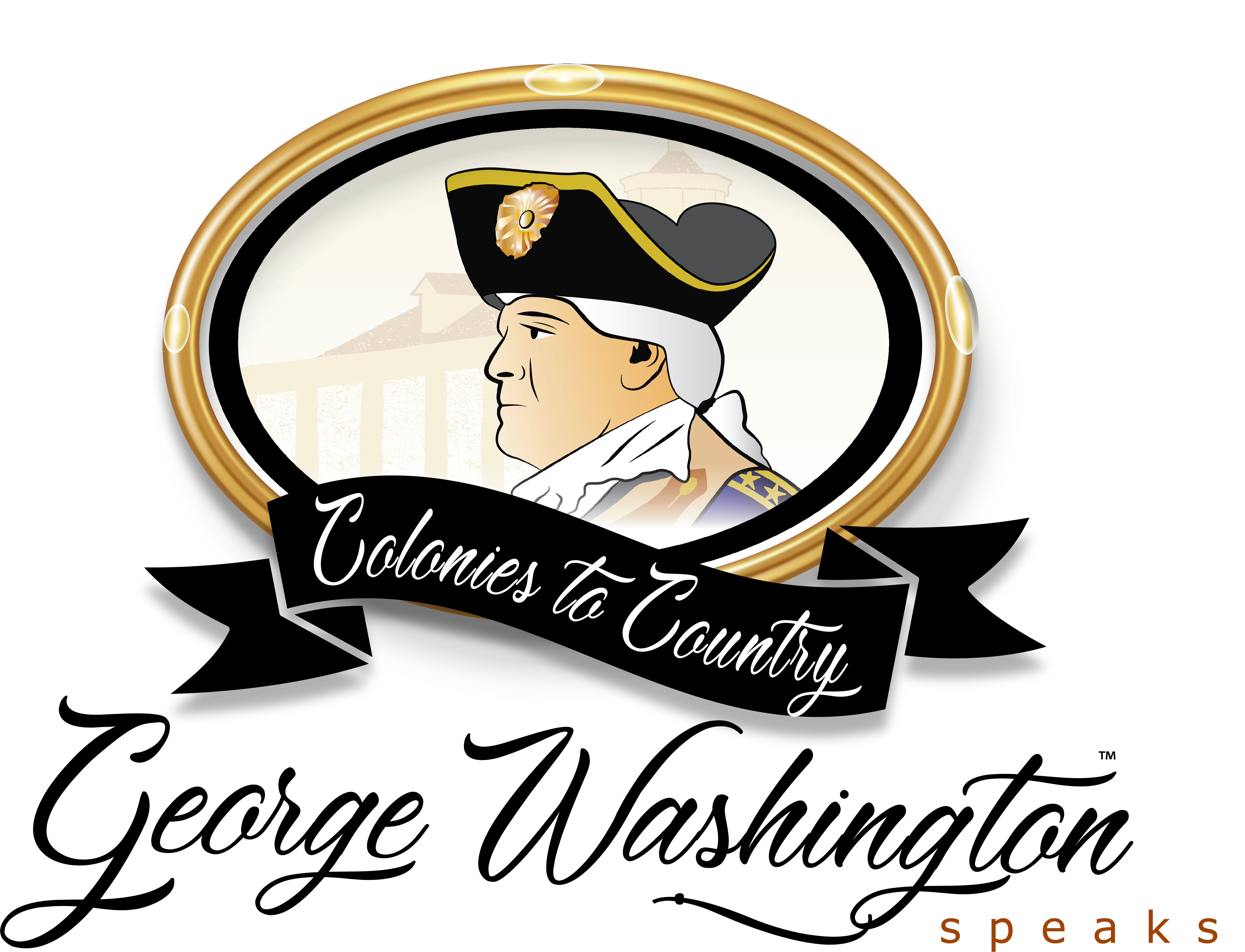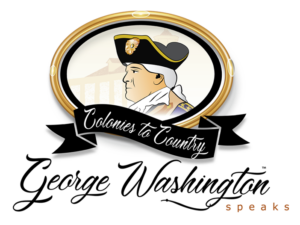
GEORGE WASHINGTON SPEAKS BLOG ARTICLES
OUR ARTICLES ARE CURRENT SO CHECK BACK AND KEEP UP ON OUR EVENTS AND NEWEST VIDEOS.
In early October I spent four days in Boston, exploring the seeds of the American Revolution, and the locations where those seeds sprouted.
I was fortunate to spend October 2 with John Adams—portrayed by Michael Lepage, who portrays a variety of 18th century figures as needed in various venues around New England. With both of us dressed in the garb of the 1700’s, we toured Lexington. Lexington Green, the Buckman Tavern, the Hancock-Clarke house, and Munroe Tavern helped me envision the events of April 1775. We stopped for a photo in front of Buckman Tavern, where dozens of Minutemen waited for the British regulars after Paul Revere’s warning of their arrival.
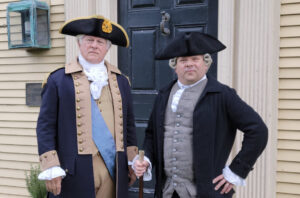
Of course, George Washington was not involved in those events. At that time, he was at Mount Vernon, carrying out his usual business there, hosting visitors, and making occasional visits to Alexandria. He left Mount Vernon in early May of 1775 to attend the Second Continental Congress, and by this time news of the battles at Lexington and Concord was spreading through the colonies.
However, in 1789 when President George Washington toured the New England states, he visited the battle site at Lexington Green, and dined at Munroe Tavern. The room he dined in is pictured here.
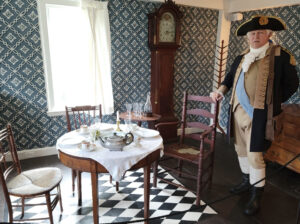
At Minuteman National Historic Park, we walked along part of the five-mile Battle Road Trail, while John Adams narrated more of the events that started the Revolutionary War, and answered my questions.
Another stop on October 2 took us to the Concord bridge, site of a second skirmish between British forces and local militia. As we approached the bridge, a couple and their baby daughter were having family photos taken. Presidents kissing babies is a political cliché, but these parents were eager to have their photos taken with the two former presidents—no kissing involved!
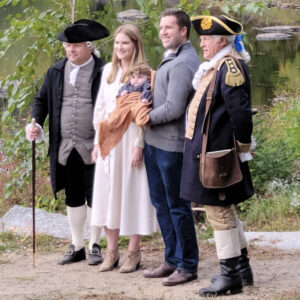
Our day ended with dinner at the 18th century Wayside Inn, a beautiful location filled with historic atmosphere.
Michael Lepage and his wife were delightful guides for the day, and made our visit to Lexington and Concord very memorable.
With gratitude,
Vern Frykholm
FARMER GEORGE WASHINGTON
For a recent presentation to students, I was asked to talk about agriculture in Washington’s life. After his birth on his father’s Popes Creek plantation, the agricultural life was Washington’s usual environment from his earliest days—the tobacco crops, the kitchen gardens and medicinal plants, the hedgerows, shade trees, and decorative plants surrounded him. His interest in them grew because his family made their living by raising and selling crops.
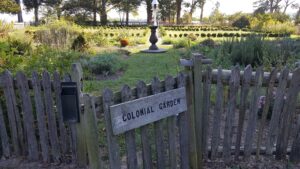
Washington also took a keen interest in animal husbandry. He bred and sold horses, and experimented with dog breeding to develop the Virginia Foxhound.
Mount Vernon’s more than 8,000 acres required a lot of management, and Washington had obligations beyond the plantation. He was a member of the House of Burgesses, and part of the Virginia militia. In 1766 he hired his distant cousin, Lund Washington—a young man in an unsettled condition—to learn farming and help manage the estate.
Washington knew tobacco depleted the soil, so he switched to growing wheat, and tried a variety of crop rotation practices to keep the farm productive.
When the American Revolution began, Lund Washington took on most of the responsibilities for management of Mount Vernon. The two of them kept up regular correspondence throughout the war—a time when the estate was losing money and virtually bankrupt. Many of their letters can be found on the National Archives website section called Founders Online.
In 1776 Washington sent Lund instructions for replacing some trees on the estate. His letter asked for: “all the clever kind of Trees (especially flowering ones) that can be got, such as Crab apple, Poplar, Dogwood, Sasafras, Lawrel, Willow (especially yellow & Weeping Willow, twigs of which may be got from Philadelphia) and many others which I do not recollect at present—these to be interspersed here and there with ever greens such as Holly, Pine, and Cedar, also Ivy—to these may be added the Wild flowering Shrubs of the larger kind, such as the fringe Tree…”
In other letters, Washington instructed Lund to propagate some of their own trees to plant around the estate. He also discussed reclaiming swampy land to create pastures, and selling parcels of land when cash was short.
Lund didn’t care much for keeping details records—information Washington was eager to have while he was away from home. In his letters, he questioned Lund about the crops, and the animals. How many colts this year? How many lambs? Sometimes horses were sold to provide cash.
After the war, Washington returned to Mount Vernon, eager to restore the estate’s productivity. Lund and his wife moved to another property of their own. When the presidency took Washington away again, he hired his nephew, Howell Lewis, to manage the estate.
Through a long stream of written correspondence, Howell provided reports on the oats, wheat, corn, and barley, the horses, sheep, pigs, and dogs. But these proved much less satisfying to Washington than seeing them for himself.
When he left the presidency, Washington was deeply gratified to return to the farming life he loved. He is quoted as saying, in 1797, “Agriculture is the most healthy, the most useful, and the most noble employment of man.”

TURNING POINTS IN THE AMERICAN REVOLUTION

Turning Points in the American Revolution
Last September my wife, Sandy, and I visited several Revolutionary War battle sites in upstate New York and Vermont. Our tour guide identified some of those battles as “turning points” in the war, but they are little known by all but the most devoted history buffs.
Although none were major victories for either side, they helped to create conditions which supported the major battles ahead. One thing led to another, as often happens. This prompted me to consider the major turning points.
The Revolutionary War lasted from 1775 to 1783, and during it several key turning points were crucial to the colonists’ success.
Lexington and Concord
In April of 1775, 700-800 British troops were sent from Boston to capture arms and ammunition the colonial militia had stockpiled in Concord. Their effort at a surprise raid was foiled by warnings from Boston patriots, and skirmishes ensued in both Lexington and Concord. The British were shocked when 3,000-4,000 colonists gathered near Concord, and they retreated amid gunfire, back to Boston.
With these skirmishes, the rebellion of the colonists became a shooting war. The “shot heard ‘round the world” ended, for all practical purposes, the attempts to reach a diplomatic resolution to British/colonial relations in America.
The Successful Siege of Boston
In the spring of 1775, British forces took total control of the city of Boston, located on a peninsula with a narrow neck connecting to the mainland, and blockaded the harbor to prevent supplies reaching the colonists. The colonial militia occupied the mainland surrounding the peninsula, and in June the British attacked them in the famous Battle of Bunker Hill. The militia fought valiantly until they ran out of ammunition. Many Patriots left the city to stay in the countryside. Loyalists from the outlying areas moved into the city, where supplies ran short, causing great hardship with the disruption of shipping in this major port.
In July, George Washington arrived to lead the newly formed Continental Army. They maintained a standoff for months, until March 4, 1776 when the Continental Army fortified Dorchester Heights, gaining a position the British could not defend against. On March 17, 1776 the British evacuated Boston (an event celebrated there as Evacuation Day), leaving the city in control of the colonists.
The success of this long stand-off proved that the colonists could defend themselves and would not give up easily. Though the British moved to New York City and continued their efforts, colonial leaders were now ready to declare their independence.
The Signing of the Declaration of Independence
The Declaration of Independence is one of the most important documents in American history. It signaled the signers’ intention to break away from Great Britain and form an independent nation. The Declaration was drafted by Thomas Jefferson in 1776 and formally adopted by the Second Continental Congress on July 4th of that year.
The document declared that the American colonies would no longer be subject to British rule, and listed 27 grievances against the British government. The document also stated that the colonies have the right to declare themselves free and independent, and that they should be treated as a sovereign nation. The signers put their lives and fortunes at risk with this document that made them traitors to the British crown.
The Declaration of Independence marked the more formal beginning of the American Revolution, and was a powerful statement that still resonates today as a reminder of the power of freedom and the strength of the human spirit.
The Battle of Saratoga
The Battle of Saratoga, fought in September and October of 1777, was the first major victory for the Americans and the first major defeat of the British in the war. The victory showed the world that the Continental Army could stand up to the mighty British and their formidable military.
British commander General John Burgoyne wanted to move south from Canada and capture the Hudson Valley so he could cut off New England from the rest of the colonies.
The Continental Army, led by General Horatio Gates, had been preparing to meet the British forces. On September 19, General Burgoyne and his troops attacked the American lines. The Americans fought bravely, but were unable to withstand the British onslaught. General Gates was forced to retreat to the nearby highlands.
The battle raged on for several days, with both sides suffering horrendous losses. Ultimately, the battle proved to be too much for the British. On October 17, General Burgoyne was forced to surrender.
The victory helped to convince the French to recognize the United States of America and enter the war on their side. The victory at Saratoga was also an important psychological victory. The American forces had been in a state of disarray and the British had been seen as invincible. For the British, the loss was a major setback.
The Franco-American Alliance
The United States’ alliance with France was negotiated by Benjamin Franklin, Silas Deane, and Arthur Lee. The alliance began in the late 1770s, when France expressed its support for the Revolution. France provided funds and supplies to help the Americans in their fight for independence. In 1778, France officially declared war on Britain, and the alliance between the two nations was sealed, and French troops were deployed to America. They also provided naval support, which proved invaluable in the naval battles against the British.
The alliance also provided the Americans with an international ally, which helped to legitimize their cause on the world stage, and rally public opinion in favor of their struggle for independence.
The Battle of Yorktown
The Battle of Yorktown was the last major battle of the conflict. It was fought from September 28 to October 19, 1781, in Yorktown, Virginia, and was a decisive victory for the American forces of General George Washington, French ground troops, and the French naval blockade.
General Washington and the Continental Army arrived in Yorktown in September of 1781. Washington had been planning to attack the British forces in New York City, but he changed his plans when he learned that a French fleet was headed to the Chesapeake Bay. He decided to attack the British forces in Yorktown instead.
Meanwhile, a French fleet under the command of Admiral Francois Joseph Paul de Grasse had arrived in the Chesapeake Bay and blockaded the British forces. The British had no way to escape. On October 19, 1781, General Cornwallis, commander of the British forces, formally surrendered.
After the battle, the British government realized that they could not win the war and decided to negotiate a peace treaty.
The Treaty of Paris
The Treaty of Paris, signed on September 3, 1783, was the final turning point that signaled the end of the war. The treaty was signed between Great Britain and the United States of America, as well as France, Spain, and the Netherlands, all of whom had played important roles in the conflict.
Under the terms of the treaty, Britain recognized the United States’ independence and ceded all of its claims to land east of the Mississippi River. This land included the newly formed states of Vermont, Kentucky, and Tennessee, as well as the Great Lakes region and the Ohio River Valley. In addition, the British agreed to evacuate all their troops from American soil, and the United States was given access to the fishing waters off Newfoundland and Labrador.
The Treaty of Paris allowed the new nation to begin its journey towards becoming a successful democracy.
While other events and victories contributed to the overall success of the American Revolution, I consider these six events the major game-changers. I would love to discuss this or answer questions. Contact me via my website or Facebook.
PAUL REVERE : HOW MANY RIDES? HOW MANY RIDERS?

GEORGE WASHINGTON SPEAKS BLOG ARTICLES
OUR ARTICLES ARE CURRENT SO CHECK BACK AND KEEP UP ON OUR EVENTS AND NEWEST VIDEOS.
Paul Revere is best known for his “midnight ride” the night of April 18, 1775, to warn colonists in Lexington and Concord that an armed force was marching their way. Our next set of videos will deal with the opening volleys of the Revolutionary War that took place the following morning.

In 1861, approximately 85 years after that event, and many years after Revere died, Henry Wadsworth Longfellow published a poem titled “Paul Revere’s Ride” which generations of Americans read, and many memorized. Longfellow used some poetic license in telling the tale, but you can read it here.
Revere was a silversmith and engraver, and an active member of the Sons of Liberty, a group devoted to freeing the colonies from British control. His house still stands today, and is a popular tourist attraction along Boston’s Freedom Trail.
On two occasions prior to April 18, Revere rode out of Boston with news for the rebels. First, he rode to Concord, where military supplies were stockpiled by the colonists, to warn of British activity in Boston. As British troop movement in Boston raised concerns, Revere rode to the outlying towns with another warning, and on his way back arranged for the signal lights from the Old North Church in Boston. “One if by land, and two if by sea” as Longfellow wrote, would let colonists know which route the British troops were taking to get to Concord and capture the military supplies.
Finally, on April 18, troops began to move out of Boston, and patriot leader Dr. Joseph Warren sent Revere out again to warn the colonists of their approach.
But Revere wasn’t the only rider that night.
William Dawes agreed to join Revere, taking the longer land route, while Revere ferried from Boston to Charlestown and borrowed a horse to ride toward Concord. Concord resident Samuel Prescott met them along the way, and guided them in the darkness, since he knew the area better. Dawes and Prescott aren’t nearly as well-known as Revere, but served with equal courage. All three encountered a patrol of British regulars after warning Lexington, but before they reached Concord. Did they escape? Retreat? Were they captured?
Plan to watch the next series of four short videos to learn the full story!
Contact me anytime at [email protected].
I am your servant,
